Forcing tulips by March 8 at home
It is an indisputable fact that the degree of a rainbow festive mood helps to raise a bouquet of magnificent tulips. Unfortunately, it is easy to make a mistake and buy flowers that are not the first freshness. But there is a way to not trivially solve this problem. Flawlessly shaped buds of excellent quality can be obtained by forcing tulips.
How not to miss the timing of distillation, the correct technology, direct planting and further care at home, we will tell in this article.
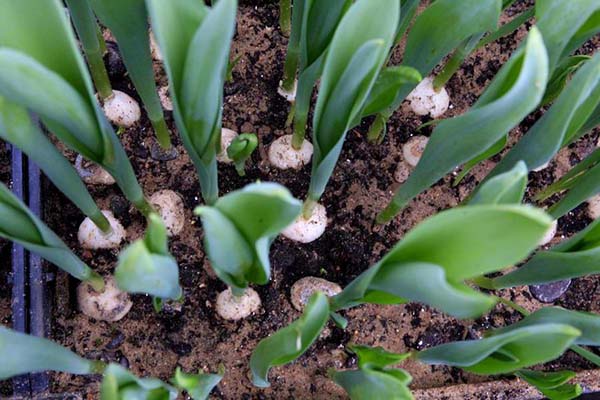
Content
When to plant tulip bulbs for distillation
By the way! Except for March 8, tulips are planted for distillation for the sake of other spring holidays, for example, for Valentine's Day or February 23.
The best time to start planting tulip bulbs for distillation is October-early November.More precise dates are determined depending on the specific holiday for which you are going to grow flowers:
- If by Valentine's Day (February 14), then you need to start planting already in early October.
- By February 23 - from the second decade (from 10) October.
- By March 8 - from the middle-third decade (from 15-20) October.
Interesting! In open ground, bulbous flowers usually begin to be planted in September. For example, the same tulips, lilies, crocuses, hyacinths, muscari, daffodils, grouse imperial.
Why exactly on these dates? But because of what:
Worth knowing! All bulbous flowers must pass resting or cooling period... The future flowering depends on its duration and quality. at this time, a flower bud is formed in the bulb.
- After planting, tulip pots should spend 90-150 days in the cold, i.e. about 3-5 months (depending on the variety);
- then 20-30 days in a warm place - before flowering (depending on the variety).
Note! Of course, you can try to plant for distillation already hatched bulbs tulips in January or Februarybut you will hardly be able to get a good flowering, because the bulbs did not have an adequate cooling dormancy period.
It's another matter if you purchase alreadychilled onions.
Technology for distilling tulips by March 8 at home
It is very tempting to create a miracle yourself in the form of a charming bouquet of flowers for the long-awaited holiday. However, to do this, several recommendations must be followed regarding the selection of suitable bulbs, the appropriate substrate, planting containers and preparation of the bulbs for planting.
Selecting bulbs for forcing
For forcing tulips by March 8, you must choose exclusively large and heavy bulbs (from 25-30 grams, with a diameter of 4-5 cm), in other words, extra class... Only such bulbs will be able to please you with powerful spring flowering, because only strong and strong (ie large) planting material can cope with "forcing" in unnatural conditions.

It is worth understanding! A large bulb is not yet a 100% guarantee, because many other factors affect flowering and flower development.
In general, it is best to purchase dutch bulbswhich specially designed for forcingthat should be written on the packaging itself.
Important! Bulbs must not only be large, but also of perfect quality.
Necessary substrate and planting container
For forcing tulips, a large amount of land is not required, so it is enough to take small pots with drainage holes. The main thing is that they height was not less than 15-20 cm. If you are going to grow many flowers at once, then it will suit youboxes or containers.
By the way! It is recommended to plant 3-5 bulbs in a pot with a diameter of 12-15 centimeters. In other words, you can plant tightly, at a distance of 1-2 cm from each other. Moreover, it is advisable to plant bulbs of approximately the same size and variety in each separate container so that they develop more or less equally.
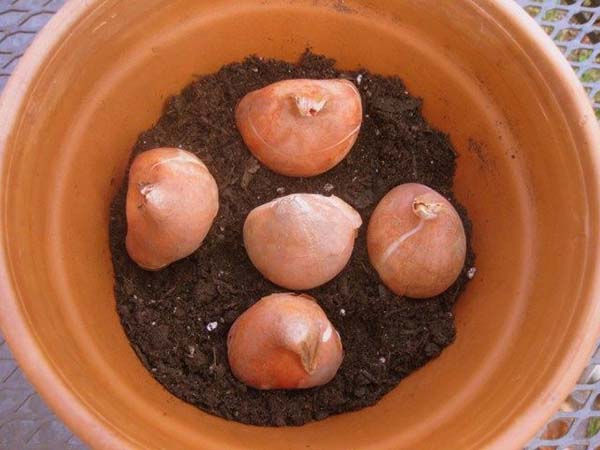
For forcing tulips, it is advisable to use quality soil, which the good moisture and air permeability, which means it should be loose... Thus, you can prepare the nutrient substrate yourself by taking in almost equal proportions garden land (a little more), excellent humus (smaller) and riversand.
Note! If you want to use garden land, then shortly before planting it must be steam in the oven and / or shed pink solution of potassium permanganate, or even better "Fitosporin", to disinfect and prevent the occurrence of possible diseases.
Better yet, put pills in the ground for extra protection "Glyokladina" from decay.
Or you can just mix purchased land for flowers (but peat based) with river sand (2 to 1).
Advice! Instead of sand, if desired and possible, you can use vermiculite.
In principle, bulbs can be planted for forcing in sawdust or sand... But it should be understood that there is no nutrition in such soil, which means that after distillation, such bulbs can simply be thrown away, but not saved in any way.
It will be very good if you add to the substrate calcium nitrate or nitroammophos (1 teaspoon for a small pot).
Preparing the bulbs for planting
Before planting the bulbs in pots, they should be properly processed, namely:
- Peel off the scales.
Important! It is not necessary to remove the scales during planting. But under them may be hidden spots of fungal diseases, therefore, in order not to plant diseased bulbs for distillation, they are undressed and examined. The peeled skin will also help the bulb to take root faster.
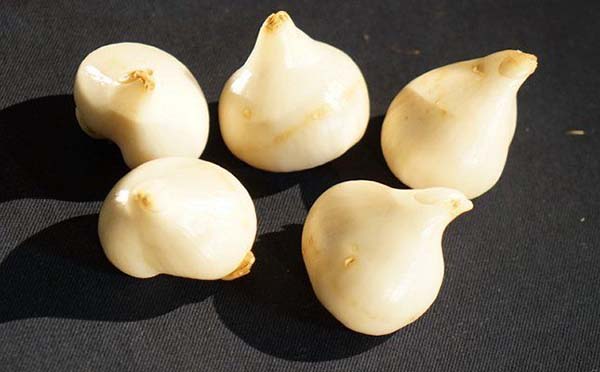
- Be sure to pickle (soak) in a solution of potassium permanganate or another disinfectant (for example, in the same solution "Fitosporin" or "Maxima") for 20-30 minutes.

Direct landing
Step-by-step instructions for planting tulip bulbs for distillation at home for the winter and spring holidays (for Valentine's Day, February 23 or March 8):
- Decide on the timing of planting the bulbs, depending on which holiday you want to get flowering bulbs.
- Purchase suitable planting material (large bulbs).
- Prepare the container, substrate and the bulbs themselves for planting.
- Fill the planting containers with the substrate.
- Moisten the ground slightly (you can spill it with a disinfecting solution).
- Bury the bulbs in the ground, but not completely so that the top (top) remains above the ground.
- If desired, to better preserve moisture, you can cover the pot with something on top, for example, a bag or container. Otherwise, you will have to water more often.
- Remove container to a cool place where temperature + 5-9 degrees, and humidity about 70% (these are optimal conditions for rooting).
Advice! At home, it is best to use a refrigerator (bottom shelf) or a glazed loggia (balcony). If you have a basement or cellar, then, of course, it is better to put the bulbs there.

Further care of tulips after planting for distillation
Now you need monitor soil moisture in pots, watering as it dries, i.e. about once a week.
As soon as bulbs tulips will hatch (after 3-5 months), they will have the first sprouts,and they reach 4-6 centimeters, can endure germination pots to the light (but not in direct sunlight) in a relatively warm room (at least + 15-18 degrees), for example, into a room on a windowsill.
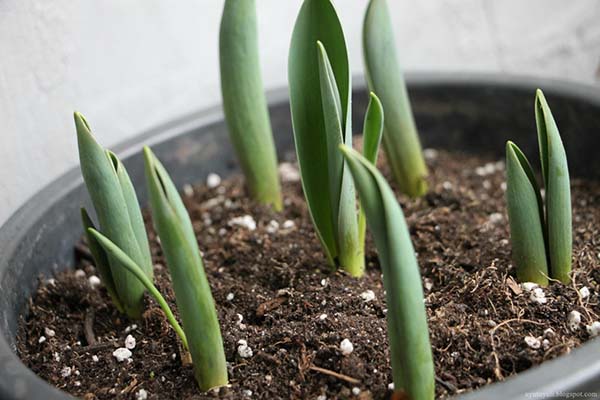
At the beginning of the growth period for more active recruitment green mass tulips You can also try feed nitrogen fertilizers (for example, solution urea or ammonium nitrate), a during budding - potassium-calcium (calcium nitrate and potassium sulfate). However, as a rule, this rarely gives a significant result, because when forcing, the plant basically takes all the nutrients from the "fat" bulb.
Important! If you see that the bulbs are late in distilling the flower stalks, then you need to increase the temperature and, conversely, if they grow too quickly (in a hurry to drive out the bud), then lower it. The same goes for lighting. Either way, you have to illuminate, i.e. for normal distillation it is necessary at least 10-12 hour daylight hours.

After about 3-4 weeks, the first buds are formed.
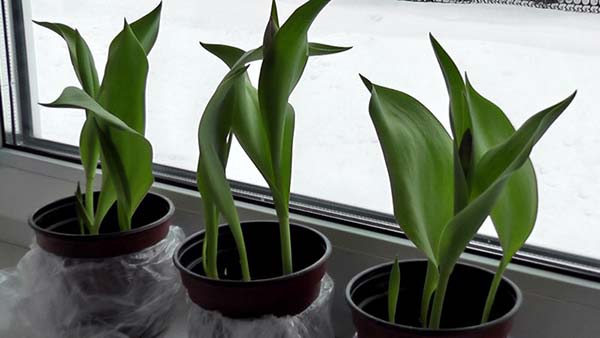
And after another week and a half, they will begin to gain color and bloom.
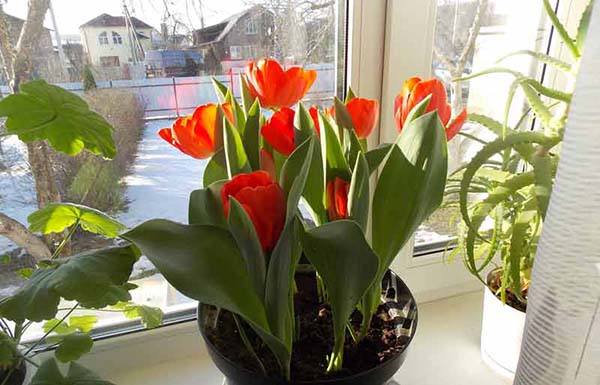
When and how to cut tulips into bouquets after distillation
The optimal cutting time depends largely on the shelf life you expect. Thus, after distillation, tulips should be cut into bouquets at the following stages, depending on the period of their further storage:
- if from 1 to 2 weeks (for sale), then in a state when the buds have not yet been colored (they have just begun to gain color).
- if for 3-4 days (specially presented for a holiday), then the buds should already be almost completely colored.
After cutting, tulips must be immediately wrapped in paper (newspaper) and stored again in a cold room (cellar or basement) or refrigerator.

By the way! "Give" water to drink you can both before storage after cutting, and shortly before donating or selling flowers (if you drove them out for sale).
To do this, you must first cut the lower part of the stems, and then put the bouquet in cold water and put it in a cool room for a day.
Video: storage and processing of tulips after cutting
Why tulips planted in the pasture don't bloom
The main reasons why bulbs planted for forcing may not bloom:
- dropped off at the wrong time;
- bought and planted weak planting material;
- used a substandard or unsuitable substrate;
Important! If you do not disinfect the soil and the bulbs themselves, then they can simply rot during the forcing process.
- did not comply with the conditions of forcing after planting (cooling-rest period and moving to warm and light conditions).
If you used your own tulip bulbs from your garden, and they did not bloom, then the reasons may be as follows, namely, leaving after flowering:
- It was a very humid summer or you watered too often and abundantly after flowering, when the bulbs gradually retired.
- The leaves were cut too early after flowering (the leaves did not have time to transfer food to the bulbs for it to mature better).
- The bulbs were untimely dug up for storage.
- It was stored incorrectly before disembarkation (the first time after excavation - + 20-23 degrees, a month before disembarkation - + 15-17 degrees).
What to do with tulip bulbs after distillation
After the tulips have faded or you cut them into a bouquet, you will have the bulbs - what to do with them?
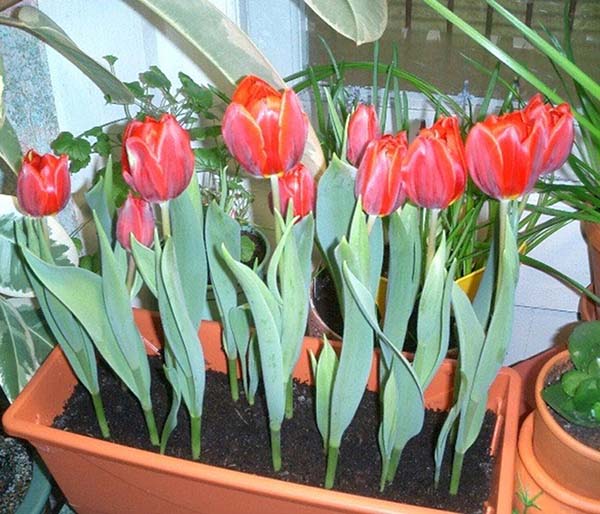
Note! Bulbs that were left without leaves after distillation (for example, they got rid of them when cutting) are not viable. They just dry up and that's it. It is useless to try to save them.
Forced bulbs tend to look quite emaciated, so there is no point in planting them outdoors in spring.
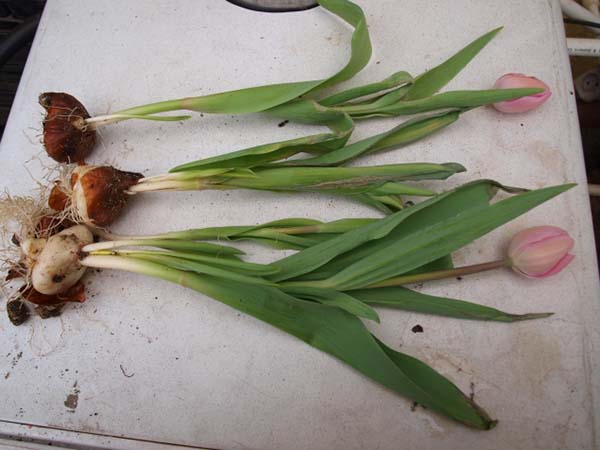
You can try to put them in storage, but before pickle in fungicide (for example, "Maxim") or in the old fashioned way in a pink solution of potassium permanganate (for 30-60 minutes). Next, the onion needs dry and store in a dry warm place until September. At the beginning of autumn, plant in the ground, unless, of course, the onion does not dry out very much (and a tiny replacement onion forms inside).
Important! After distillation, the bulbs will bloom only after a year, the next year they will not bloom with a 90% probability.
By the way! And after a couple of years of proper care, if the bulbs grow large and healthy, then you can use them for forcing.
Humanly understandable is the desire to give a loved one a bouquet of fresh tulips for a holiday. One way to do this without disappointing with the quality of the flowers is forcing. However, you need to think over this process to the smallest detail: do not miscalculate with the timing, choose the right planting material, soil, planting container and take into account many other important details, without which it is difficult to expect success.
Video: forcing bulbs by March 8
By the way! Also suitable for forcing hyacinths (best of all, even easier than tulips), crocuses, daffodils and galanthuses (snowdrops). The technology for growing them at home is almost identical.

